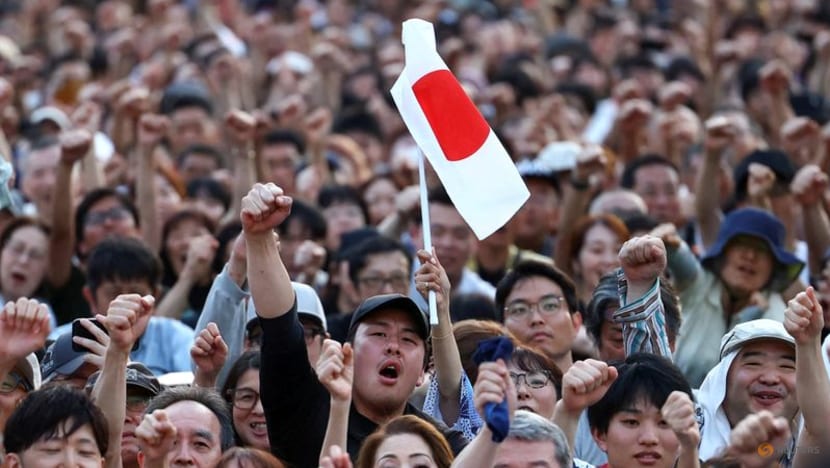Commentary: Japan enters a new phase in politics with rise of 'Japanese First'
The bigger question is not whether Prime Minister Shigeru Ishiba will resign after his coalition lost an important election, but what Sanseito’s rise means for Japan, says political scientist Yasuo Takao.


This audio is generated by an AI tool.
PERTH: Japan’s Upper House election on Jul 20 was about more than Prime Minister Shigeru Ishiba’s ruling coalition losing its majority, and whether he will now resign.
It signalled a new phase in Japanese politics, with the “Japanese First” Sanseito party emerging as a major victor. What was once a fringe sentiment expressed by a few conservatives has now taken centre stage.
A defining feature of the election was the politicisation of foreigner-related issues, led by Sanseito’s aggressive campaign to revise government policies that have allowed a “silent invasion”. This hardline stance forced other parties to address the topic, making immigration policy a central issue.
This marked a stark contrast to the Lower House election just months earlier, when the emphasis was on expanding foreign labour recruitment.
Sanseito now has 14 seats in the 248-seat chamber, up from just one that it secured three years prior. It now holds enough seats to independently submit legislation in the Upper House, except for budget Bills.
TAPPING INTO PUBLIC ANXIETIES
Immigration has long been a sensitive issue in a rapidly ageing Japan facing chronic labour shortages, though the growing unease is also about overtourism. It comes at a time when the country reported both a record number of foreign residents (3.77 million as of the end of 2024) and a record number of tourists (21.51 million in the first half of 2025).
Sanseito openly advocates for stopping welfare benefits to foreigners, restricting their hiring and enforcing stricter cultural conformity – even proposing a system to “check the loyalty” of foreigners.
These exclusionary narratives have gained traction by tapping into public anxieties, particularly those driven by economic hardship and social uncertainty. Such rhetoric has created a distorted sense of crisis, suggesting that Japan is being “overrun” by foreigners and is somehow losing its national identity.
In reality, Japan’s foreign residents – roughly one in every 33 people – are vital contributors to society. They pay taxes, work in critical industries and help maintain essential public services. Blaming them for the country’s challenges is not only factually wrong but also dangerously divisive.
The party’s rise has not come without controversy. Sanseito has been widely criticised for spreading misinformation. Fact-checking initiatives by media outlets intensified during the election, with many articles flagged as misinformation focused on claims relating foreigners to crime or preferential treatment.
BEHIND THE SURGE
So, who are the voters behind Sanseito’s surge? The answer lies partly in changing voter demographics.
While the ruling coalition suffered heavy losses, parties like Sanseito gained significant ground – especially among younger voters. Turnout increased most notably among people in their 20s to 40s, while elderly participation remained flat. This generational shift helped fuel Sanseito’s rise.
Its success can also be attributed to its savvy digital election strategy.
Survey data suggests that those who favoured Sanseito were heavily influenced by video-sharing sites and social media platforms such as X (formerly Twitter) and often harboured deep distrust of traditional media and government institutions. This made them more inclined to shift political allegiance – an opening Sanseito was quick to exploit. The party dominated online search trends and amassed over 100 million views on YouTube.
In this election, voter turnout reached levels high enough to impact the outcome, particularly among new participants mobilised through social media platforms. Estimates suggest this group may have accounted for 3 to 5 million votes, a large portion of which likely went to Sanseito.
IS JAPAN HEADED DOWN FAR-RIGHT PATH?
Against this backdrop, the national debate over immigration and identity is intensifying. Why has the issue of foreign residents become such a political flashpoint now?
It is a pivotal moment for Japan to seriously reflect on the benefits and challenges of immigration – and to consider what kind of society it wants to be.
Whether “Japanese First” takes the same shape as “America First” or whether Sanseito will follow in the footsteps of far-right parties in Europe like Alternative for Germany or Reform UK remains to be seen.
Sanseito has tapped into a similar economic anxiety and public frustration to attract protest votes against the political establishment. Unlike European “immigration nations”, however, Japan has consistently rejected the notion of adopting a formal immigration policy.
Successive prime ministers have emphasised that the acceptance of foreign workers is a labour policy – not an integration strategy. The foreign resident population also remains relatively low at about 3 per cent in Japan – compared to the European Union, where 6.4 per cent of residents were non-EU citizens as of January 2024.
Japan is unlikely to face the deep polarisation seen in parts of Europe. Despite the LDP-Komeito coalition losing its Upper House majority, potential alliances with other conservative parties, such as the Democratic Party for the People and Nippon Ishin, suggest continued political stability.
As in Europe, where populist parties have often moderated once in power, Sanseito’s true direction will become clearer in parliamentary deliberations.
Although sweeping policy changes are unlikely in the short term, symbolic shifts are already evident. Even before the latest election, the Democratic Party for the People and Nippon Ishin re-submitted a Bill to regulate land acquisitions by foreigners. The Ministry of Education recently excluded international students from a major research grant programme, responding to concerns that they made up 40 per cent of recipients.
While these moves may not immediately impact daily life, they signal a growing exclusionary undercurrent that could subtly but significantly reshape Japan’s foreigner-related policies.
But one thing is clear: If exclusionary politics continue to gain ground, Japan risks eroding its longstanding identity as a peaceful and inclusive society. Building consensus across diverse views and backgrounds is the only viable path forward for Japan’s future.
Dr Yasuo Takao is Adjunct Senior Research Fellow of Political Science at Curtin University.



















